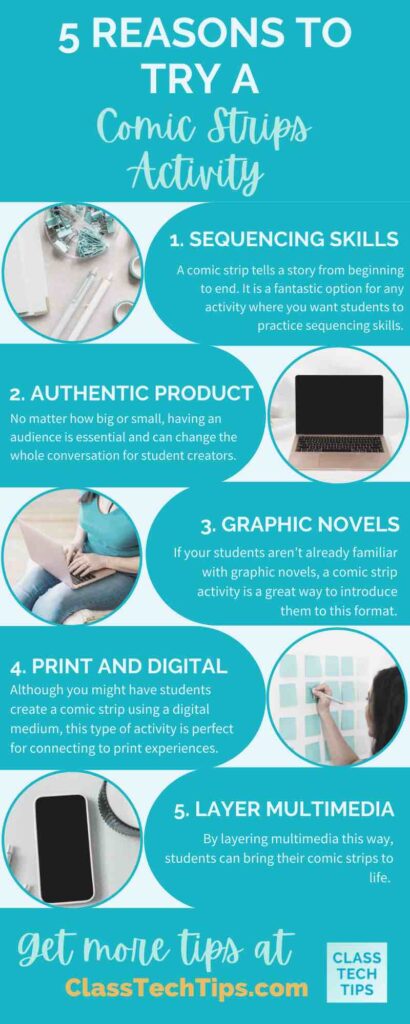Looking for a creative project idea for your students? Try a comic strips activity in your classroom. With a comic strip activity, you can help students sequence events as they retell the steps for a science experiment, learn about graphic novels as a choice for independent reading, and start to think about whether they prefer to share in digital or print formats.
In today’s blog post, I share five reasons to try a comic strip activity. And I have a free download for you — 15 ready-to-use comic strips templates for your next lesson.
Let’s jump into the list of five reasons to try a comic strip activity!

Why Try a Comic Strips Activity
Practice sequencing skills
A comic strip tells a story from beginning to end. It is a fantastic option for any activity where you want students to practice sequencing skills. Students can retell the events leading up to a critical historical moment or retell what happened in a story they read.
You might provide a list of temporal words for students to use, like: First, Then, Later, Next, Finally. Or you might share examples of comics that use this type of language in the caption. One reason to try out a comic strip activity with students is to help them practice sequencing – which can connect to any subject area.
Create an authentic product

Late last year, I gave a keynote to about 750 educators in Wisconsin to kick off the SLATE Conference. During the keynote, I spoke about the students as creators, and I shared a clip from a podcast episode I had listened to earlier that month. The clip included an interview with Jeff Kinney, the author of the Diary of a Wimpy Kid series. This episode of the podcast, The Press Box, was all about his origin story and how he became a writer. And when the host asked him about this, Jeff Kinney said: “I always had that decision to make every day, which was should I do this term paper? That will be seen by my one professor. Or should I do my comic? Which will be seen by 30,000 people. And my grades really suffered, but I cut my teeth.”
Now I’m not saying students need to have an audience of 30,000 or 3,000 or even 300 to make their work special. But, no matter how big or small, having an audience is essential and can change the whole conversation for student creators. So one reason to consider using comic strips with students is to connect them to an audience that will celebrate their work.
Pique interest in graphic novels
If your students aren’t already familiar with graphic novels, a comic strip activity is a great way to introduce them to this format. Your primary purpose for a comic strip project could be to get students excited about the idea of reading comics. Students who aren’t super motivated as independent readers might be more willing to give graphic novels a chance after making their own comic.
You might decide to reach out to a media specialist in your school or a librarian in your community. If you’re not familiar with graphic novels or are teaching a subject area like math or science, this person could serve as a resource for recommendations of graphic novels.
Connect print and digital experiences
Although you might have students create a comic strip using a digital medium, this type of activity is perfect for connecting to print experiences. For example, students can explore graphic novels in paperback format or comics from a newspaper. You might provide the option for students to create a comic strip on paper or with digital tools. This is a great way to show students that both online and offline experiences have value, and there are plenty of ways to express themselves — both with or without digital tools.
Layer multimedia

Students can share their comics in many different ways. One fun option is to use the green screen option in Flipgrid. Students can save their comic strip as an image and add it to the background of a Flipgrid response. By layering multimedia this way, students can bring their comic strips to life. They might read it aloud with emotion and expression or share the story behind what they created.
If you want to try out a comic strip activity with students, check out these free templates I made. It also includes instructions on how to make your own comic templates for students. Click here to download the ready-to-use comic strip templates.







